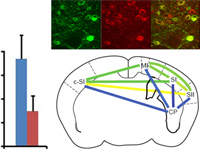The mammalian brain is composed of many brain structures, each with its own ontogenetic and developmental history. We used single-nucleus RNA sequencing to sample over 2.4 million brain cells across 18 locations in the common marmoset, a New World monkey primed for genetic engineering, and examined gene expression patterns of cell types within and across brain structures. The adult transcriptomic identity of most neuronal types is shaped more by developmental origin than by neurotransmitter signaling repertoire. Quantitative mapping of GABAergic types with single-molecule FISH (smFISH) reveals that interneurons in the striatum and neocortex follow distinct spatial principles, and that lateral prefrontal and other higher-order cortical association areas are distinguished by high proportions of VIP+ neurons. We use cell type-specific enhancers to drive AAV-GFP and reconstruct the morphologies of molecularly resolved interneuron types in neocortex and striatum. Our analyses highlight how lineage, local context, and functional class contribute to the transcriptional identity and biodistribution of primate brain cell types.
